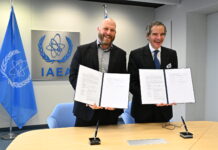NASA’s Orion Spacecraft: Enhancing Astronaut Safety in Deep Space
NASA’s Orion spacecraft is at the forefront of protecting astronauts from the harsh conditions of deep space. This cutting-edge vehicle is specifically designed to shield its crew from the severe environment encountered far from Earth. During the uncrewed Artemis I mission, NASA, along with several international collaborators, utilized the Orion spacecraft to conduct critical research into radiation exposure that astronauts might face on future missions. This mission marked a significant step towards ensuring the safety of astronauts venturing beyond low Earth orbit.
Comprehensive Radiation Measurements: A Closer Look
During its 25.5-day mission, the Orion spacecraft orbited the Moon and returned to Earth, equipped with 5,600 passive sensors and 34 active radiation detectors. These instruments meticulously measured radiation exposure within the Earth’s Van Allen radiation belt, an area known for its high levels of radiation. The wealth of data collected was analyzed and published in a comprehensive scientific study, a collaborative endeavor by NASA’s Space Radiation Analysis Group, the German Space Center (DLR), and the European Space Agency (ESA).
The findings indicate that while radiation exposure can vary depending on the location within the spacecraft, Orion is equipped to effectively protect its crew from potentially dangerous levels of radiation during lunar missions. This capability is crucial as space radiation presents significant risks to humans on long-duration space flights, highlighting the importance of these findings for future exploration missions to the Moon and eventually Mars.
Advanced Instruments for Radiation Detection
To measure radiation levels inside Orion, NASA deployed several sophisticated instruments, including the Hybrid Electronic Radiation Assessor (HERA) and the Crew Active Dosimeter. These tools had previously been tested on the International Space Station, ensuring their reliability. Additionally, ESA contributed its Active Dosimeter to the mission’s instrumentation.
HERA’s radiation sensor is designed to alert crew members in the event of a sudden increase in radiation, such as a solar flare. This allows them to take shelter and minimize exposure. Meanwhile, the Crew Active Dosimeter is capable of collecting real-time data on radiation doses received by astronauts, transmitting this information back to Earth for continuous monitoring. By conducting radiation measurements in different areas of the spacecraft, researchers could assess the varying levels of shielding offered by Orion’s design.
Simulating Human Exposure to Radiation
An innovative experiment known as the Matroshka AstroRad Radiation Experiment was also part of the Artemis I mission. This collaboration between NASA and the DLR involved placing radiation sensors on and inside two life-sized manikin torsos, which were designed to mimic human tissue. By measuring radiation doses on different parts of these manikins, researchers gained valuable insights into how radiation might affect astronauts traveling in deep space. Such studies are crucial for developing protective measures for future crewed missions.
Orion’s Design: A Robust Shield Against Radiation
The results from the Artemis I mission confirmed that Orion’s design is effective in shielding its crew from potentially hazardous radiation levels during lunar missions. However, researchers observed that radiation exposure could vary significantly based on the spacecraft’s orientation in specific environments. For instance, during an engine burn of the Interim Cryogenic Propulsion Stage, Orion’s altered orientation resulted in a significant reduction in radiation levels, demonstrating the directional nature of radiation within the Van Allen belt.
Stuart George, NASA’s lead author on the study, emphasized the importance of these findings, stating, “These radiation measurements show that we have an effective strategy for managing radiation risks in the Orion spacecraft. However, key challenges remain, especially for long-duration spaceflights and the protection of astronauts on spacewalks.”
Looking Ahead: Continued Efforts in Radiation Risk Mitigation
NASA’s commitment to mitigating space radiation risks is ongoing. Future missions will rely heavily on the data collected during Artemis I to enhance spacecraft shielding, optimize trajectory, and account for solar activity. The same radiation measurement hardware used on Artemis I will be employed in the upcoming Artemis II mission, the first crewed mission around the Moon, to deepen our understanding of radiation exposure inside Orion and ensure the safety of astronauts on their journey to the Moon and beyond.
For more information on NASA’s Artemis program, visit the official NASA website at: https://www.nasa.gov/artemis.
In conclusion, NASA’s Orion spacecraft represents a significant advancement in protecting astronauts from the risks of space radiation during deep space missions. The Artemis I mission has provided invaluable data that will guide future exploration efforts, ultimately paving the way for humanity’s return to the Moon and its journey to Mars. As NASA continues its research and development, the lessons learned from these missions will be instrumental in ensuring the safety and success of future space explorers.
For more Information, Refer to this article.


































